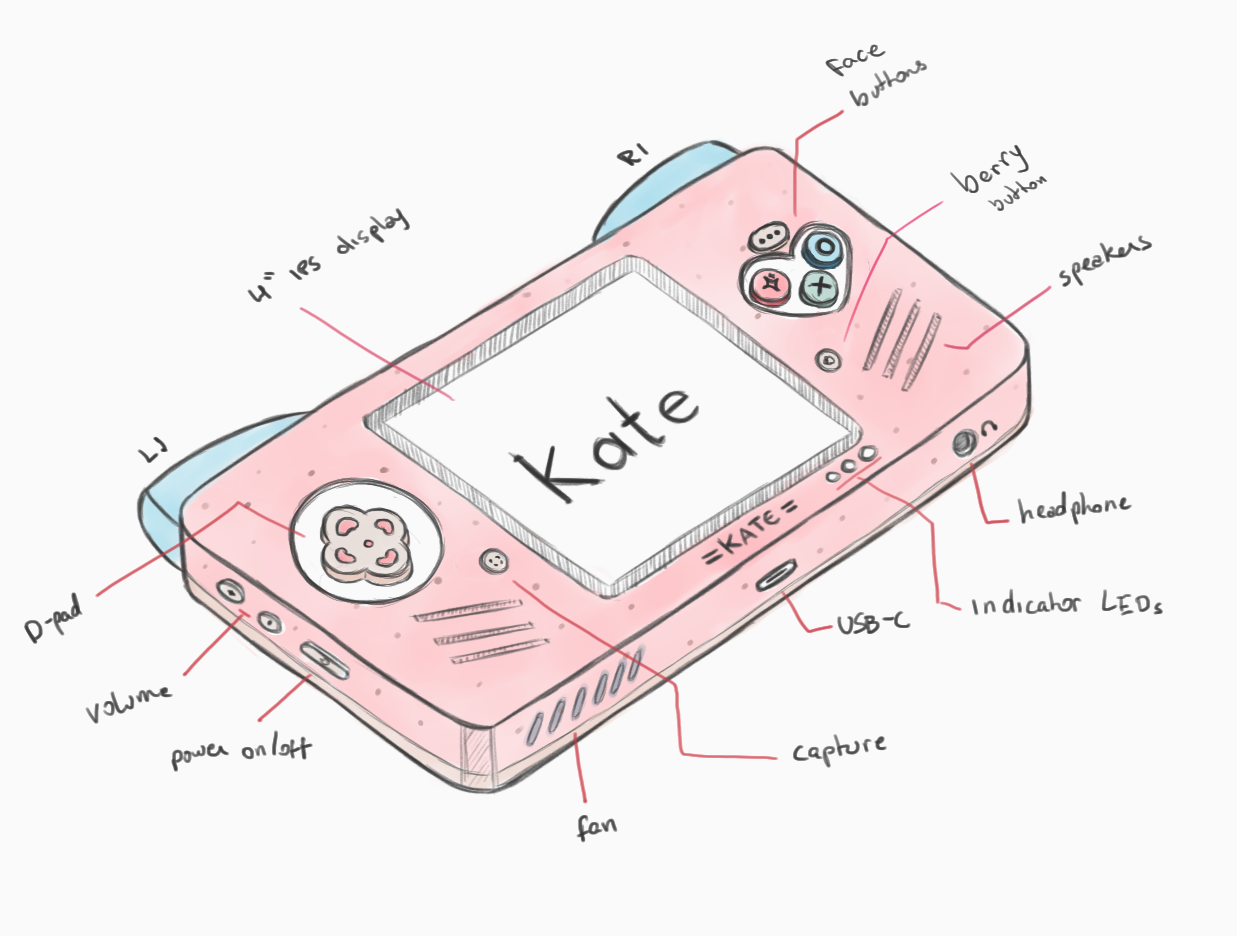Overview#
Before you start planning any DIY project, you need to know what you’re going to be building. Kate has a few proposed projects that fit the same “Kate video game console”, but can be customised to fit your own aesthetics and wishes.
What’s Kate?#
Kate is a video game console with its own operating system and application format, so it primarily only runs games that are made specifically for Kate. There’s also the possibility of emulating games that would otherwise run on a browser if they meet certain requirements (e.g.: they don’t require internet connection to a remote server to run).
The main goals of Kate as a gaming system are:
To be hackable: users should be able to modify any aspect of the system to suit their needs, from the hardware to the software to the aesthetics. To support this all of Kate is released under permissive open-source licences: MPL-v2.0 for code, and Creative Commons 4.0 for non-code resources.
To be understandable: Kate is an open and layered system. It’s intentionally kept reasonably small such that users can read and understand the entirety of what they’re running. On top of that, we aim to provide full documentation of all features, together with their underlying formal (mathematical) model, security proofs, and complete threat models.
To be safe: we encourage everyone to publish cartridges for Kate and also to play any cartridge they find interesting. To support this we need to provide a baseline of safety, and Kate does it by installing and running cartridges in fully isolated and sandboxed processes, with very few permissions. There’s a modern Capability-Security system which takes care of letting cartridges do more while putting users fully in control of how much trust they want to put on the cartridge and which risks they’re willing to take.
To be accessible: we want as many people as possible to be able to build and run Kate, so the system should run with moderate resources and not require a large amount of money and time. We try to achieve this by making the system itself free, picking less expensive components as a recommended basis, and allowing people to run emulated versions of the Kate system on devices they already own — all while supporting as much of the other goals as possible.
To be democratic: anyone should be able to develop and publish games for Kate. And they should, ideally, be able to do so with tools they’re already familiar with, too. Kate achieves this by making all development tools open, and by supporting web games to be emulated in the console even when playing it fully offline without any additional server software.
To be open: it should be very difficult for a single party to control the system and its ecosystem. We try to make as much use of open and auditable standards as possible, as well as pick decentralised-first architecture designs for features that can have an impact on this (e.g.: the game catalog is fully decentralised, anyone can run one, and we rely on public key verification for determining trust and provenance).
To be by humans and for humans: it’s a specific goal of Kate that curation, suggestions, and similar be done by people, and for people. This is done in the game catalog, where people can create their own curation feed and others can subscribe to those feeds, but it also applies to features like the Play habits, where we try to put the player in control of which data they want to store and how they want to process that data (i.e.: if they want suggestions based on them, they have to write programs that analyse and correlate the data themselves).
What does Kate look like?#
Kate can look like anything you want — that’s the beauty of a hackable game console. But if you want some inspiration, or just want something that will work, the following are official designs for different Kate versions that you can build, all based on the same Cats x Sweets x Strawberry theme.
Note
3D models for the cases along with detailed build instructions are planned to be added to this document over the course of 2024, but they’re not currently available. If you plan to build one of the consoles listed below you’ll also have to do your own 3D modelling for the cases.
The Cheesecake Vending Meow-chine#

A small box that can play games, music, and other media, but which requires you to connect to an external HDMI display in order to see or play anything. Comes with stereo speakers for playing music directly, a small low-power screen for displaying the current system status, and a CD/DVD drive to load games distributed in physical media.
The Cheesecake version is by far the easiest project to build out of all of them, as it requires no soldering, no batteries, and very few GPIO connections. For controls, the Cheesecake can take both wireless and wired gamepads.
The Pink Paw-cake#

A handheld console with a similar form-factor to classic consoles like the PSP and the Gameboy Advance. A 5” screen is recommended (as the standard minimum Kate games will consider when testing), but you can try a 4” one if you want a more compact look and will be playing more pixel-art games than visual novels.
The Pancake version is a more serious project, requiring wiring multiple buttons, fiddling with ribbon cables in a small enclosure, and getting batteries to work correctly.
